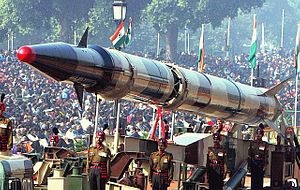The New York-based Council on Foreign Relations (CFR) has published a new report, Strategic Stability in the Second Nuclear Age, by Gregory Koblentz, a professor at George Mason University. It’s relatively short, at 41 pages, and covers nearly all the nuclear-armed states with the exception of North Korea and Israel.
About half the report is a useful overview of existing nuclear capabilities and technological trends, and the conclusions are broadly familiar: deterrence relationships are getting more complex, new non-nuclear technologies (missile defense, anti-satellite weapons, conventional counterforce, and cyberwarfare) are potentially disruptive, and “South Asia … is the region most at risk of a breakdown in strategic stability due to an explosive mixture of unresolved territorial disputes, cross-border terrorism, and growing nuclear arsenals.” Where it gets more interesting is in the recommendations it makes for dealing with the nuclear order in Asia.
Koblentz calls on the Obama administration to “discourage India from pursuing missile defense capabilities,” on the basis that “these efforts will provoke qualitative and quantitative improvements in Pakistani and Chinese missiles that will circumvent or overwhelm Indian defenses.” He urges the U.S. to support “official government-to-government talks between India and China on issues related to strategic stability,” arguing that Indian and Chinese policies “overlap considerably” anyway.
He wants India and Pakistan to be urged to “adopt further confidence-building measures” and hold more Track 2 dialogues. He laments “the “thinness” of the military and civilian arms control bureaucracies and insufficient depth of expertise outside of government” in these countries, and therefore calls on the U.S. to “train and educate promising young scholars, scientists, and practitioners from India and Pakistan in arms control and nonproliferation.” (On that subject, see Michael Krepon on Generation Why.)
More broadly, Koblentz suggests convening a Strategic Stability Working Group comprised of the seven “established” nuclear weapon states, discussing a much wider range of issues than the current “P5 plus.” He argues that “a broader forum might provide political cover to jump-start a Sino-Indian nuclear dialogue, shelter an Indo-Pakistani dialogue from the vagaries of their domestic politics and international crises, and provide an opportunity for the United States and Pakistan to continue discussing these issues at times when their bilateral relations are poor.” He also speculates that “this working group could provide another mechanism for multilateralizing previously agreed-to or future bilateral agreements,” such as a collective agreement not to field potentially destabilizing MIRVed missiles.
These are reasonable – if over-ambitious – ideas, although some, notably the emphasis on Track 2, the criticism of Asian expertise, and the identification of “territorial disputes” as a destabilizing factor, will be met with wariness, and even hostility, in Delhi. Without a clear appreciation of the radically different perspective on non-proliferation and strategic stability that one finds in India, these suggestions simply won’t get traction.
But in many ways, the report does precisely what Indian analysts and officials have long sought: it situates the India-Pakistan nuclear relationship in the broader triangular context including China, and thereby gives credence and support to the Indian view that their nuclear policies must be developed with both Islamabad and Beijing in mind. While plenty of Track 2 channels do exist, Indian elites typically complain that China has refused to view India as a nuclear peer, all the while boosting Pakistan’s nuclear program, and that all this is a way of forcing India into a South Asian – rather than Asian, or even global – nuclear box. Beijing is probably a greater impediment to a meaningful Sino-Indian nuclear dialogue than Delhi.
At the same time, it is undeniable that India’s domestic debate over the relationship between technology and deterrence has, with some exceptions, been extremely thin, with comparatively little serous analysis of the likely second- and third-order effects of non-nuclear technologies. The situation may be quite different inside government, but the writings of former officials don’t suggest this.
Part of the reason for this thinness is the Indian association between arms control and coercion. Indian analysts often argue that Pakistan’s nuclear steps – including the development of tactical nuclear weapons – are intended to heighten precisely this international concern in regional nuclear stability, and therefore generate diplomatic pressure on India in non-nuclear areas, including Kashmir.
Arms control – or even strategic dialogue – thereby becomes viewed as a political weapon. See, for instance, the contemptuous terms in which former Indian diplomat Shyam Saran talked about a “strategic restraint regime,” a decade-old Pakistani proposal, in his landmark speech last year. The very idea of restraint has become bogged down in bilateralism. Koblentz’s suggestion that any strategic stability dialogue be embedded in a multilateral context is therefore a useful one, because it takes some of the sting out of the charge that India is being hyphenated, so to speak, in nuclear terms.
Shashank Joshi is a Senior Research Fellow of the Royal United Services Institute (RUSI) in London and a PhD Candidate at Harvard University.

































